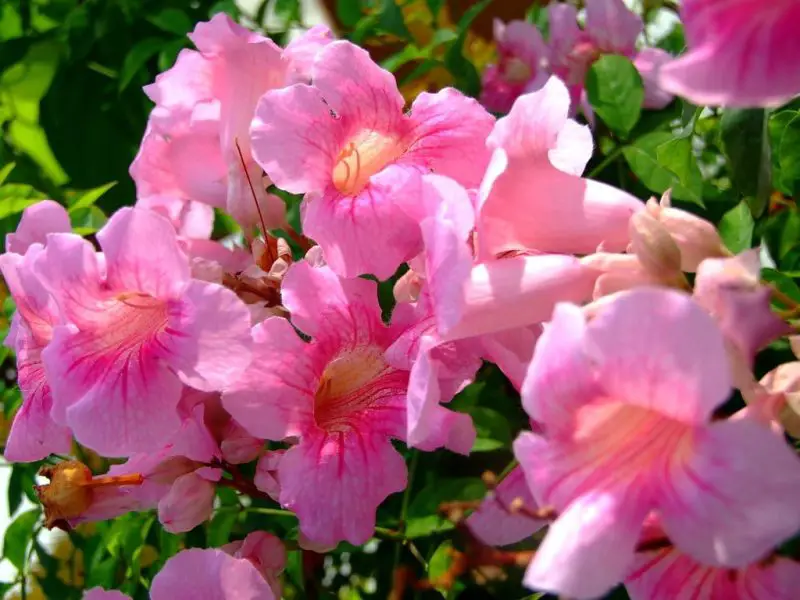Trumpet vines are among the most striking climbing plants, loved for their brilliant, trumpet-shaped flowers and fast-growing nature. These vibrant blooms attract hummingbirds and butterflies, turning any garden into a lively, colorful retreat. With their vigorous growth, trumpet vines can quickly cover fences, trellises, and walls, making them a favorite choice for adding height and drama to outdoor spaces.
However, while these vines are hardy and resilient, their blooming cycle often leaves gardeners curious and sometimes even frustrated. Understanding why trumpet vines bloom, what affects their flowering, and how to encourage more blossoms can help you enjoy their beauty year after year.
Understanding about the Trumpet Vine Blooming Cycle

The trumpet vine blooming cycle follows a clear seasonal rhythm. The plant begins its growth phase in spring as temperatures rise. During this stage, strong shoots and lush green foliage develop quickly. This period is essential for building the energy reserves needed for blooming. The vines need sunlight, water, and nutrient-rich soil to prepare for flower production.
By early summer, the trumpet vine enters the bud initiation stage. Small buds form along the stems and gradually enlarge. Warm weather combined with long daylight hours encourages rapid development. The plant channels energy from leaves into the buds. This process can take several weeks, depending on growing conditions. Healthy vines at this stage promise vibrant flowers.
Peak blooming occurs in mid to late summer. The trumpet-shaped flowers open and display bright orange or red hues. Pollinators, especially hummingbirds, are drawn to the blossoms. The bloom cycle may last until early fall in favorable climates. After blooming, the plant sets seed pods, preparing for winter dormancy. Understanding each stage helps gardeners plan care properly. It ensures healthy vines and prolonged flowering.
Why Trumpet Vines Sometimes Skip Blooming Seasons
Trumpet vines are known for their bold and vibrant flowers. Yet sometimes, they fail to bloom even in the right season. Several factors can cause this. Most commonly, the plant is still young. Trumpet vines usually need three to five years to mature before producing flowers. During this time, they focus on root and foliage growth instead of flowering.
Another reason is pruning at the wrong time. These vines bloom on new growth, so trimming too late in spring or early summer removes flower buds. Excess nitrogen in the soil can also lead to leafy growth without blooms. Gardeners who fertilize lawns nearby may unintentionally overfeed trumpet vines. Sunlight is another critical factor. These plants need at least six to eight hours of full sun to bloom. Shady locations can prevent flowering altogether.
Stress from poor conditions also plays a role. If trumpet vines are exposed to drought, poor soil, or transplant shock, blooming may pause for a year. Overcrowding or lack of space can restrict energy for flowers. Pests or diseases may further weaken the plant, limiting its ability to produce blooms. The good news is that trumpet vines are resilient. With patience, proper pruning, full sun, and balanced care, most will eventually return to a healthy blooming cycle.
General Blooming Season of Trumpet Vines
Trumpet vines are famous for their long and colorful blooming season. These vigorous climbers usually start producing flowers in late spring or early summer. The exact timing depends on your region, soil quality, and weather conditions. In warmer climates, trumpet vines may begin blooming earlier and continue longer into the year.
The flowers usually last through summer and may continue until early fall. Their bright orange or red trumpet-shaped blooms appear in clusters and attract hummingbirds and pollinators. The abundance of flowers makes them a favorite choice for covering fences, walls, and trellises. In ideal conditions, trumpet vines can bloom for several months without interruption.
However, young trumpet vines may not bloom immediately. They often need several years of growth before showing their full potential. Proper care, sunlight, and pruning also influence the length and intensity of the blooming period. When well-maintained, trumpet vines reward gardeners with a spectacular and prolonged floral display each year.
Blooming Cycle by Climate Zone
Trumpet Vines in Cool Climates
Trumpet vines can face challenges in regions with cooler climates, as the shorter summers and colder winters limit their growth and flowering potential. In areas with long, harsh winters, trumpet vines may struggle to establish strong root systems and can be slow to produce blooms. Gardeners in these regions often notice delayed flowering, with the first blooms appearing later in the season, sometimes not until late summer. Ensuring that the plant is placed in a sunny, sheltered location is essential for giving it the warmth it needs to thrive. Mulching around the roots also helps protect against frost damage and improves soil insulation.
Despite these difficulties, trumpet vines can still add color and interest to cooler gardens if given proper care. Pruning in early spring allows for healthier growth and helps stimulate budding when warmer weather arrives. Using rich, well-draining soil combined with organic matter supports stronger development. In some cases, growing trumpet vines in containers may be a practical solution, as they can be moved to sunnier or more protected spots. With extra attention to placement and seasonal protection, trumpet vines in cool climates can reward gardeners with vibrant late-season blooms.
Trumpet Vines in Warm Climates
Trumpet vines flourish in warm climates, where abundant sunshine and long growing seasons encourage vigorous growth and consistent flowering. These regions provide the heat that trumpet vines naturally crave, making them reliable bloomers from late spring through early fall. The warmth helps them establish quickly, often leading to dense foliage and an abundance of trumpet-shaped flowers. Gardeners in hot climates can expect vibrant orange-red blooms to attract hummingbirds, bees, and butterflies for months at a time. Regular watering during dry spells is important, though once established, trumpet vines can tolerate periods of drought fairly well.
However, the vigorous growth in warm climates can sometimes turn into a challenge, as trumpet vines may spread aggressively if not managed properly. They can quickly overtake fences, trellises, or walls, so routine pruning is necessary to keep them under control. Pruning after the main blooming season also encourages repeat flowering while preventing excessive spreading. Gardeners should also be mindful of where they plant trumpet vines, as their strong roots may damage structures or compete with nearby plants. With thoughtful placement and care, trumpet vines in warm climates deliver stunning, long-lasting blooms that add energy and bold color to outdoor spaces.
Trumpet Vines in Moderate Zones
In moderate zones, trumpet vines enjoy a balance of warm summers and relatively mild winters, making them well-suited to thrive and bloom consistently. These regions typically provide enough heat for strong flowering, without the extreme cold or heat that can stress the plant. Gardeners in moderate climates often see trumpet vines bloom from mid-summer into early autumn, with blossoms returning year after year. The consistent seasonal rhythm allows the vines to establish deep roots, ensuring steady growth and reliable flowering cycles. This makes trumpet vines a favorite for adding bold vertical accents to pergolas, trellises, or garden fences.
While trumpet vines are easier to manage in moderate zones compared to extreme climates, they still require attention to pruning and placement. Without regular trimming, the plant can spread quickly and overwhelm other nearby vegetation. Pruning during late winter or early spring keeps growth under control and stimulates healthy flowering. Moderate rainfall and fertile soil in these zones often support the vine naturally, though occasional deep watering during dry spells is beneficial. With just a few care routines, trumpet vines in moderate zones can provide both beauty and structure, rewarding gardeners with dependable, eye-catching blooms throughout the growing season.
Sunlight and Its Role in Blooming
Trumpet vines are sun-loving plants that depend heavily on light for strong blooming. Full sun exposure encourages the production of energy through photosynthesis. This process fuels flower development and helps the plant produce more buds. When vines receive at least six to eight hours of direct sunlight daily, they achieve their maximum blooming potential. Shady spots may allow growth but often result in fewer flowers. For gardeners who want vibrant displays, choosing a bright planting site is essential.
The direction of sunlight also plays a role in how trumpet vines bloom. Southern and western exposures generally offer the most intense light during the day. These conditions support longer flowering periods and brighter colors. East-facing gardens provide moderate light that can still encourage healthy blooming, though with slightly fewer flowers. In contrast, northern exposure usually lacks sufficient sunlight for consistent flowering. Understanding light direction helps gardeners position vines where they can thrive. Proper placement ensures that energy is directed into flowers instead of weak, leafy growth.
Seasonal changes affect sunlight levels and can influence blooming success. During summer, longer days provide abundant light that drives heavy flowering. In fall and winter, shorter days reduce energy, slowing down flower production. Gardeners in regions with cloudy or rainy weather may notice delayed or reduced blooming. To overcome this, vines can be trained on trellises or fences in sunnier spots. Reflective surfaces, such as light-colored walls, can also boost available light. By adjusting placement and monitoring seasonal light changes, gardeners can support steady and reliable blooming. The more sunlight trumpet vines receive, the more impressive their floral display becomes.
Soil Conditions for Blooming Success
Watering Needs for Continuous Blooms
Trumpet vines are hardy plants, but they still need consistent watering to produce abundant flowers. During the active growing season, the soil should stay slightly moist without becoming soggy. Too much water can cause root rot, while drought stress reduces bloom production. A deep watering once or twice a week is usually enough, depending on local climate conditions. Gardeners should always check the soil before watering, ensuring the top few inches are not already wet.
In hotter climates, trumpet vines often require more frequent watering to cope with faster evaporation. Mulching around the base can help retain soil moisture and regulate temperature. However, water should not be applied directly against the stem to avoid fungal issues. Established vines are more drought-tolerant, but even mature plants benefit from regular deep watering during prolonged dry spells. This practice encourages stronger root systems and more vibrant blooms.
Overwatering is a common mistake when caring for trumpet vines. The key is balance: enough water to sustain steady growth, but not so much that the roots sit in saturated soil. Drip irrigation or soaker hoses provide a steady supply of moisture without waste. With the right watering routine, trumpet vines reward gardeners with long-lasting, colorful flowers throughout the season.
Fertilizer and Nutrients for Strong Blooms
Balanced Fertilization for Consistent Flowering
Fertilization is crucial in helping plants maintain steady and vibrant blooms. A balanced fertilizer containing nitrogen, phosphorus, and potassium supports different growth stages. Nitrogen helps leaves stay green and healthy, phosphorus encourages strong root systems, and potassium improves overall flowering and resistance. Without the right balance, flowers may appear smaller, duller, or fail to bloom entirely. Applying a slow-release fertilizer allows plants to receive nutrients gradually, preventing stress from sudden changes. Gardeners should follow recommended guidelines carefully to avoid over-fertilization, which can damage roots and reduce blooms.
The timing of fertilizer application also matters. Most flowering plants respond best when fertilized during active growth and budding. Early spring feeding gives plants an energetic start, while mid-season feeding helps extend flowering. Avoid fertilizing late in the season, as this encourages leafy growth rather than flower production. Organic options, such as compost or well-rotted manure, also provide essential nutrients while improving soil structure. Fertilizing should always be combined with proper watering to allow nutrients to absorb fully. When done consistently and correctly, balanced fertilization ensures strong, healthy blooms that last longer and maintain rich color throughout the flowering season.
Micronutrients and Their Hidden Importance
While macronutrients are often emphasized, micronutrients are equally essential for strong flowering. Elements like magnesium, iron, zinc, and boron play critical roles in plant metabolism and flower formation. Magnesium supports chlorophyll production, while iron assists in energy transfer within plant cells. A lack of these nutrients can cause yellowing leaves, weak stems, or reduced blooming. Though required in smaller amounts, micronutrients create balance within the plant’s system, ensuring energy is directed toward flower development. Gardeners often overlook these hidden nutrients, leading to uneven or stunted growth.
Correcting micronutrient deficiencies requires attention to soil testing and the use of supplements when needed. Epsom salt, for example, provides magnesium and can be applied in diluted form. Chelated iron is another option for plants struggling with chlorosis. Seaweed extract is a natural source of trace elements and can boost resilience against stress. Over-supplying micronutrients, however, can harm plants, so careful application is key. Combining micronutrients with organic matter ensures better availability in the soil. By respecting both macro and micronutrient needs, gardeners create the right environment for sustained blooming. Healthy flowers not only last longer but also appear more vibrant, reflecting a plant’s complete nutritional balance.
Pruning Techniques to Enhance Blooming
Pruning plays a key role in keeping plants healthy and full of flowers. Removing old or damaged stems allows the plant to redirect energy into new growth. This process encourages the development of strong buds that will bloom with greater vibrancy. Regular pruning also improves airflow around the plant, helping to prevent disease and fungal issues.
Timing is important when pruning for blooms. Many flowering plants produce buds on either old or new wood. Pruning at the wrong time can remove potential flowers. For example, plants that bloom on old wood should be pruned immediately after flowering. Those that bloom on new wood can be pruned in late winter or early spring. Understanding your plant’s growth pattern ensures you cut at the right stage.
When pruning, focus on shaping the plant for both beauty and structure. Cut back crossing or crowded branches to allow sunlight to reach all parts. Always use clean, sharp tools to avoid damaging the stems. Removing faded blooms, known as deadheading, also stimulates continuous flowering. With consistent care, pruning helps your plants stay healthy, balanced, and rich with blossoms season after season.
Age of Plant and Blooming Maturity
The age of a plant plays a central role in its blooming performance. Young plants often focus on establishing strong roots and foliage before producing flowers. This early stage can sometimes disappoint gardeners who expect immediate blossoms. However, this phase is necessary for long-term growth and consistent blooming. With patience, plants will shift energy toward flower production as they mature.
Most flowering plants reach their peak blooming capacity after two to three years. During this time, they have developed a healthy root system and a sturdy structure. Mature plants can then produce larger numbers of flowers with stronger colors and longer-lasting petals. For perennials, maturity ensures more reliable seasonal blooms. Annuals, on the other hand, often bloom earlier but with shorter lifespans. Understanding these differences helps gardeners set realistic expectations.
Proper care also influences how quickly a plant reaches blooming maturity. Adequate sunlight, correct watering, and balanced fertilization encourage faster development. Pruning can also stimulate new growth that leads to earlier flowering. Ignoring these needs may delay the plant’s blooming potential for several seasons. By recognizing the natural growth stages, gardeners can provide support at the right time. This balance ensures healthy plants and continuous flowers year after year.
Pests and Diseases Affecting Blooms
Common Pests That Reduce Flowering
Several pests can significantly reduce blooming if not controlled in time. Aphids are one of the most common threats. They feed on plant sap, causing curled leaves and weak stems that fail to support flowers. Whiteflies are another problem, sucking nutrients and leaving plants with stunted growth. Spider mites thrive in dry conditions and create fine webs, weakening flower buds before they open. Caterpillars and beetles also chew on foliage and buds, directly damaging potential blooms. When pests are left unchecked, plants spend energy on survival instead of flower production. Early detection is essential to minimize harm. Regular inspection of leaves and stems helps spot infestations before they spread. Natural predators like ladybugs can keep pest populations under control. In severe cases, insecticidal soaps or horticultural oils may be necessary to protect plant health. Maintaining balanced soil and proper watering also strengthens plants against pest attacks.
Healthy plants with strong immunity are more resistant to pests. A well-fed plant produces more energy for growth and blooming. Overuse of nitrogen fertilizers, however, can attract pests and delay flowering. Balanced fertilization ensures steady growth without excess soft foliage. Removing heavily infested leaves prevents pests from spreading quickly. Companion planting with pest-repelling herbs such as basil or marigold offers natural protection. Rotating plant locations in the garden also reduces the buildup of pests over time. With consistent care and early management, blooms remain vibrant and healthy throughout the growing season. Prevention remains the best defense against pests that threaten flower production.
Common Diseases That Affect Blooming
Fungal diseases are among the leading causes of poor blooming. Powdery mildew is common and appears as a white coating on leaves and stems. It prevents plants from absorbing sunlight, weakening them before flowers form. Botrytis blight affects buds and petals, leaving them brown and withered. Rust spots and leaf spot diseases reduce plant energy, limiting their ability to produce blooms. Root rot is especially harmful, as it cuts off water and nutrients. Plants with root damage often fail to bloom at all. These diseases thrive in damp, poorly ventilated conditions, making preventive care essential. Proper spacing between plants improves air circulation and reduces fungal growth.
Bacterial and viral diseases can also limit blooms, although they are less common. Mosaic virus distorts leaves and buds, often leading to incomplete or misshapen flowers. Bacterial wilt spreads quickly in warm, wet soils, causing sudden plant collapse. While some diseases cannot be fully cured, they can be managed through good gardening practices. Removing infected plant material helps stop disease spread. Watering at the base instead of overhead keeps foliage dry and lowers fungal risks. Using disease-resistant plant varieties is another long-term solution. Crop rotation and soil improvement also help keep pathogens under control. With preventive care, plants remain strong enough to focus energy on flower production. Healthy growing conditions are the key to disease-free blooms.
Seasonal Tips for Stunning Color
Spring Care for Trumpet Vines
Spring marks the beginning of growth for trumpet vines. As temperatures rise, vines awaken and prepare for the new season. Early pruning helps remove old wood and shapes the plant for balanced growth. Fertilizer at this stage provides nutrients for stronger shoots. Phosphorus-rich fertilizer supports healthy roots and prepares vines for abundant flowers. Sunlight exposure is also important. Place vines where they receive at least six hours of full light daily.
Gardeners should inspect plants carefully for winter damage. Remove any broken or dead branches to allow energy to flow to new growth. Secure vines to trellises or fences to guide proper climbing. Mulching the base helps retain soil moisture during unpredictable spring rains. Water when the soil is dry, but avoid overwatering. Consistent spring care creates a strong foundation for summer blooms. With careful preparation, trumpet vines enter the next season healthier and ready to flower.
Summer Care for Maximum Flowers
Summer brings the peak blooming season for trumpet vines. Flowers appear in clusters, attracting hummingbirds and butterflies to the garden. Regular watering is critical, especially in hot climates where soil dries quickly. Deep watering once or twice a week keeps roots healthy. Check soil moisture before watering to avoid soggy conditions. Mulching prevents rapid evaporation and keeps the root zone cooler.
Pests and diseases are most active in summer. Inspect leaves and buds regularly for aphids, mites, or mildew. Remove pests by hand or with insecticidal soap. Deadheading spent blooms encourages vines to produce more flowers. Light pruning also helps control size without reducing bloom production. Summer is the best time to enjoy trumpet vines in full color. With consistent care, plants reward gardeners with vibrant flowers lasting until autumn. Healthy maintenance ensures long-lasting, eye-catching displays throughout the warm months.
Fall Care to Prepare for Dormancy
Fall signals the slowing of growth for trumpet vines. As days shorten, plants prepare for winter dormancy. Begin by pruning lightly to control vine size. Remove weak or diseased branches to improve plant health. Clean the area around the base to remove fallen leaves and debris. This prevents pests from overwintering near the plant. Reducing watering is essential as temperatures drop. Moist but not soggy soil helps roots prepare for the cold season.
Adding mulch around the base offers insulation during freezing nights. Thick organic mulch helps protect root systems from frost damage. Avoid fertilizing in fall, as it encourages new growth too late in the season. Instead, allow vines to conserve energy for spring regrowth. Train any long shoots to their supports before winter winds arrive. Fall care ensures trumpet vines survive harsh weather and return stronger in spring. Proper seasonal preparation creates a continuous cycle of healthy growth and stunning blooms year after year.
How to Extend the Blooming Season
Extending the blooming season of flowers requires consistent care and timely actions. Deadheading, or removing faded flowers, is one of the simplest techniques. This practice prevents the plant from putting energy into seed production. Instead, it encourages the development of new buds and prolongs the blooming cycle. Regularly checking your plants and removing spent blooms can make a big difference in the garden.
Nutrient management also plays a vital role in extending blooms. Flowers benefit from a steady supply of balanced fertilizer during the active season. Slow-release or liquid fertilizers with higher phosphorus content help stimulate continuous flower production. Avoid over-fertilizing with nitrogen, as it promotes leaf growth instead of flowers. Adequate watering is equally important, as stressed plants tend to bloom for shorter periods. Keeping the soil evenly moist without waterlogging ensures steady growth and prolonged flowering.
Another way to extend the blooming season is by staggering planting times and choosing varieties with different flowering periods. This technique creates overlapping blooms and a longer display of color. For perennial plants, proper pruning after the first flush can often trigger a second round of blooms. Additionally, mulching helps regulate soil temperature and retain moisture, keeping plants healthy throughout the season. With the right combination of care, nutrition, and planting strategies, gardeners can enjoy vibrant flowers for many more weeks.
How to Encourage Trumpet Vines to Bloom Again
Trumpet vines may sometimes pause blooming, but the right care can help restore their flowers. Understanding what they need is the first step. Sunlight, pruning, water, and nutrients all affect their bloom cycle. Without these essentials, vines often grow leaves but not flowers.
Start by ensuring the plant gets full sun. Trumpet vines need at least six hours of direct light daily. Without enough sun, they focus energy on foliage growth. Proper watering also matters. Too much water can limit flowers, while too little causes stress. Aim for deep but infrequent watering.
Pruning is another key step to encourage blooming again. Cut back old or weak stems in late winter or early spring. This directs energy toward new flowering shoots. Avoid heavy nitrogen fertilizers, as they promote leaf growth instead of blossoms. Instead, choose a balanced or phosphorus-rich fertilizer. With patience and consistent care, trumpet vines will reward you with their striking, trumpet-shaped flowers again.
Common Blooming Problems and Solutions
Buds Failing to Open
One common blooming problem is when flower buds form but do not open. This issue often results from inconsistent watering or sudden temperature fluctuations. Drought stress causes buds to dry out before they can bloom fully. On the other hand, overwatering may lead to root rot, which reduces the plant’s ability to supply energy to developing buds. Poor soil nutrition also contributes, especially if the plant lacks phosphorus and potassium. These nutrients are essential for healthy flower formation and successful blooming.
To solve this problem, start by checking soil moisture levels regularly. Ensure the plant receives consistent watering without extremes of dryness or sogginess. Adding a layer of organic mulch can help regulate soil temperature and retain moisture. Fertilize with a balanced, bloom-boosting fertilizer that is rich in phosphorus and potassium. If sudden frosts are a concern, cover plants with a protective cloth during cold nights. With consistent care and stable conditions, buds are more likely to open successfully and display their full beauty.
Flowers Dropping Too Early
Sometimes flowers bloom beautifully but drop much earlier than expected. This issue often occurs when plants face environmental stress such as excessive heat, low humidity, or irregular watering. High winds can also cause blooms to fall prematurely. Another contributing factor is insufficient pollination, which may trigger flowers to drop before they can set seeds. Overfertilizing with nitrogen-heavy products can make the plant focus on leafy growth instead of sustaining flowers.
The solution involves creating a more stable growing environment. Water plants deeply and consistently, especially during hot or dry weather. Avoid overhead watering, as wet petals may drop faster. Fertilize with a well-balanced formula, avoiding excess nitrogen. If pollination is a concern, encourage pollinators by planting companion flowers nearby. In windy areas, provide support or choose a more sheltered planting spot. With these adjustments, flowers are more likely to remain on the plant for their full lifespan, ensuring a longer and more satisfying display.
Uneven or Sparse Blooming
Another common problem is uneven or sparse blooming across the plant. Some stems may flower heavily while others remain bare. This often results from inadequate sunlight, poor pruning practices, or nutrient imbalances. Plants that do not receive at least six hours of direct sunlight usually produce fewer flowers. Improper pruning, especially cutting at the wrong season, may remove developing buds. Soil lacking in essential nutrients can also weaken the plant, resulting in fewer blooms.
To improve flowering, ensure the plant is positioned in a spot with adequate sunlight exposure. Prune carefully, following the recommended timing and techniques for the specific species. A late or overly aggressive prune can drastically reduce flower production. Feed the plant with a balanced fertilizer designed for flowering plants, and refresh the soil with compost or organic matter to improve fertility. Regularly inspect the plant to spot signs of stress early. With proper light, nutrients, and pruning, the plant will produce a fuller and more even display of flowers across the growing season.
Benefits of Trumpet Vine Blooms
Trumpet vine blooms bring vibrant beauty to gardens with their bold trumpet-shaped flowers. Their striking orange, red, or yellow tones stand out against the lush green foliage. These blossoms create a tropical atmosphere and add a dramatic touch to fences, pergolas, or trellises. The plant’s long flowering season ensures months of brilliant color in outdoor spaces.
Beyond aesthetics, trumpet vine flowers play a valuable ecological role. They are rich in nectar, which attracts hummingbirds, butterflies, and bees. These pollinators help increase biodiversity and support the overall health of the garden. The constant visits from wildlife create a lively and dynamic environment that many gardeners enjoy observing.
Another benefit of trumpet vine blooms is their resilience and low-maintenance nature. Once established, the plant requires little care while continuing to produce abundant flowers. This makes it an ideal choice for both beginner and experienced gardeners. Their fast growth also provides quick coverage, making them excellent for creating natural shade or privacy screens. The trumpet vine bloom is both beautiful and functional.
Landscaping Ideas with Trumpet Vines
Using Trumpet Vines on Arbors
Arbors make an excellent choice for supporting trumpet vines in the garden. Their sturdy frames handle the vine’s vigorous climbing nature. Once trained, the vines quickly cover the structure, offering a lush and colorful display. The flowers cascade from above, creating a tunnel of vibrant hues. This effect transforms a simple arbor into a dramatic centerpiece within the landscape.
For best results, position arbors in locations that receive full sunlight. Trumpet vines require at least six hours of direct light daily. Prune regularly to manage growth and prevent the plant from overwhelming the structure. Balanced pruning also ensures steady flower production throughout summer. With consistent care, trumpet vines on arbors provide a seasonal display of beauty and shade. Gardeners often use them to mark entryways or frame pathways, enhancing the sense of arrival in outdoor spaces.
Combining Trumpet Vines with Other Plants
Trumpet vines shine when paired with complementary plants in the garden. Their vivid flowers provide strong contrast against green foliage. Planted alongside shrubs, they add height and texture variety. Perennials with softer tones help balance the bright trumpet blooms. This layering effect creates depth and harmony in planting beds.
Select companions that thrive in full sun for best results. Plants with staggered bloom times extend seasonal interest beyond the trumpet vine’s peak. For example, spring bulbs can offer early color, followed by the trumpet vine’s summer display. Autumn perennials then close the year with warm tones. This thoughtful combination ensures continuous color and variety throughout the growing season. With the right mix, trumpet vines enhance visual appeal and attract diverse pollinators, enriching the entire landscape.
FAQ About Trumpet Vines Blooming
What is the best time to plant trumpet vine?
The best time to plant trumpet vine is in spring or early fall. These seasons provide mild weather that helps roots establish quickly. Planting in spring allows vines to grow before summer heat. Fall planting gives them time to settle before winter dormancy. Both ensure healthy, vigorous growth.
How often should trumpet vine be watered?
Trumpet vine needs regular watering when newly planted. Water deeply once or twice weekly to help roots grow strong. Once established, it becomes drought-tolerant and requires less frequent watering. During hot or dry periods, occasional deep watering keeps the vine healthy and encourages more blooms.
Do trumpet vine blooms attract pollinators?
Yes, trumpet vine blooms are excellent for attracting pollinators. Their bright tubular flowers draw hummingbirds, bees, and butterflies. These pollinators feed on the nectar and help fertilize the plant. By planting trumpet vine, you can create a vibrant and lively garden environment full of beneficial wildlife.
How do I encourage more trumpet vine flowers?
To encourage more trumpet vine blooms, plant it in full sun. Prune the vine regularly to remove excess growth and redirect energy to flowers. Avoid high-nitrogen fertilizer, as it promotes leaves instead of blooms. Consistent care and sunlight will reward you with abundant, showy flowers each season.
Can trumpet vine become invasive?
Yes, trumpet vine can be invasive in some regions. It spreads aggressively through underground runners and self-seeding. To control it, prune frequently and remove unwanted shoots. Planting in a contained space or using barriers can prevent overgrowth. With proper management, you can enjoy its beauty without garden takeover.
Final Thoughts on Blooming Trumpet Vines
Trumpet vine blooms are more than just striking flowers; they are a gift to any garden. With their vibrant colors, they attract hummingbirds, butterflies, and bees, creating a lively, pollinator-friendly space. These blossoms also bring a sense of tropical beauty and charm, making gardens feel more inviting. Their ability to thrive in various conditions makes them a dependable choice for gardeners seeking long-lasting summer color. By nurturing trumpet vines, you not only enjoy breathtaking flowers but also support biodiversity and a healthier, more vibrant outdoor environment.






